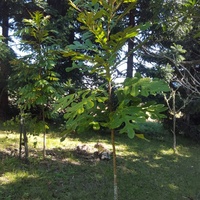Common name: Atherton oak
Other common names: Blue almond tree, Cream silky oak, White oak
Description
Atherton oak is a landscape and nut-bearing tree closely related to the Macadamia (Macadamia integrifolia) and originates in Australia, in the Atherton Tablelands, an elevated area in the tropical north of the continent.
In native forests, it is a medium-sized tree up to 30 m (100 ft) tall, with a slender trunk of about 50 cm (1.6 ft) diameter and with slight buttresses on large trees. On open sites, it is more typically 10 to 15 m (30 to 50 ft) tall, when young with a low-branching habit forming a pyramidal crown, this becoming rounded with age. The bark is smooth, grey-brown and usually mottled.
The leaves change shape as the tree ages, after several leaf exchanges from oblong-oval on seedlings to predominately deeply lobed, oak-leaf-shaped on young trees and are large, from 30 to 60 cm (1 to 2 ft) long. They are dark glossy green above, pale green or rusty brown underneath and remain on the tree throughout the year, though during normal leaf-exchange the older leaves become a brilliant orange or red-orange before falling to the ground, adding to the tree's ornamental interest.
The flowers resemble those of the Macadamia and Ivory Curl (Buckinghamia celsissima), being thin creamy-white tubes closely assembled in bottle-brush-like spikes up to 30 cm (1 ft) long. They come into bloom in the rainy season, coinciding with summer in its native range and are followed by nippled, disc-shaped fruit about 4 cm (1.6 in) wide, as well as long.
The fruit are green-skinned when young, become bright blue or purple when mature and have thin whitish pulp surrounding a hard-shelled nut with a single seed inside.
Use
The seed or kernel enclosed in the nut is edible and has long been eaten by native Australians. Similar to the Macadamia nut, the flesh is white, creamy, nutty and oily but with a milder, somewhat sweeter taste.
The oak-shaped leaves have been assessed for their potential as cut-foliage for the floral industry and show excellent promise as accent foliage or backing greenery, particularly in large floral arrangements.
The wood weighs around 675 kgs per cubic meter (42 lbs per cubic ft), has straight-grained creamy-yellow heartwood and is moderately resistant to rot and decay, with an in- and above-ground life expectancy rated at seven to fifteen years. However, it is not readily available as a sawn timber, due to the tree's relative scarcity and the logs being mostly of a small diameter.
In its native northern Australia, Atherton Oak is cultivated as a street and landscape tree, for its shapely form, eye-catching foliage and the shade it provides.
General interest
The diversifolia part of the botanical name refers to the different leaf shapes that form at different stages of the tree's life.
Climate
Atherton oak grows naturally in humid subtropical and tropical mid-elevation climates, generally frost-free areas with annual lows of 13 to 18°C, annual highs of 22 to 28°C, annual rainfall of 1100 to 3500 mm, and a dry season of 4 months or less.
Atherton Oak does not thrive in tropical areas where the average low of the coldest month is above 15°C (59°F), or that of the warmest month is above 21°C (70°F).
Growing
New plants are usually started from seed, which lose their viability quickly and are best extracted from the nuts of freshly harvested fruit. Sown in containers with a free-draining potting mix, most start to germinate within two weeks. After which, they need tending in a nursery for nine to twelve months, or until they are 50 to 90 cm (23 to 35 in) tall.
Seedlings after planting out are highly susceptible to sun scorch and moisture stress, so need shading, water and mulch until they become established.
Performs best on deep, rich, free-draining clay and loam soils of a moderately acid to moderately alkaline nature, generally with a pH of 5.0 to 8.0, and on sites with full to partial sun expose.
Atherton Oak is slowing-growing and starts to flower and fruit only when about seven to eight years old.
Problem features
The fruit are relatively large and not easily dispersed, except by terrestrial or tree-dwelling animals. It is recorded as naturalised in non-native areas of Australia, probably as a result of human introduction and cultivation. There does not appear to be any record of it anywhere as a weed.
Where it grows
References
Books
-
Barwick, M., et al. 2004, Tropical & subtropical trees : a worldwide encyclopaedic guide, Thames and Hudson, London
-
Janick, J., & Paull, R. E. 2008, The encyclopedia of fruit & nuts, CABI Publishing, Wallingford, Oxfordshire
-
Lake, M. 2015, Australian rainforest woods : characteristics, uses and identification, CSIRO Publishing, Collingwood, Victoria
-
Peate, N. & Macdonald, G. & Talbot, A. 2006, Grow what where : over 3,000 Australian native plants for every situation, special use and problem area, 3rd ed., Bloomings Books, Richmond, Victoria, Australia
-
Randall, R. P. 2002, A global compendium of weeds, R.G. and F.J. Richardson Press, Melbourne


